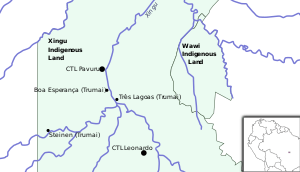Trumai
The Trumai (or Trumaí; native name: Ho kod ke)[3] are an indigenous people of Brazil. They currently reside within the Xingu Indigenous Park, in the state of Mato Grosso. They have a population of 258 in 2014.[1] They were 97 in 2011 and 120 in 2006,[2] up from a low of 26 in 1966.
| Total population | |
|---|---|
| 258 (2014)[1] | |
| Regions with significant populations | |
| Languages | |
| Trumai[2] | |
| Religion | |
| Traditional tribal religion |
Background

The Trumai are one of the last groups to have settled on the upper Xingu River, moving there in the 19th century[1] from the region between the Xingu and Araguaia Rivers, as a result of attacks from another people.[5] They currently live in four villages in the Xingu Indigenous Park, Terra Preta, Boa Esperança, Steinen and Terra Nova, situated halfway from the Leonardo Villas-Bôas Post and the Diauarum Indigenous Post, where some families also live.
The Trumai are one of the ethnicities included in the standard cross-cultural sample.
They are considered the ones who introduced the jawari ritual ("hopep" in the Trumai language), that is, along with the kwarup, one of the most important inter-tribal festivals in the Upper Xingu cultural complex.[6]
Language
The Trumai language is not closely related to other languages, and it is considered a language isolate.[2] It is severely endangered, as children are becoming native speakers of Awetï, Suyá, or Portuguese.
Notes
- "Trumai: Introduction." Povos Indígenas no Brasil. Retrieved 30 March 2018.
- "Trumai." Ethnologue. Retrieved 24 Feb 2012.
- "Trumai: Name."Povos Indígenas no Brasil. Retrieved 24 Feb 2012.
- Guirardello-Damian R, Trumai K, Trumai T (2017). "Trumai". In Stenzel K, Franchetto B (eds.). On this and other worlds: Voices from Amazonia (pdf). Berlin: Language Science Press. pp. 163–185. doi:10.5281/zenodo.1008781. ISBN 978-3-96110-018-7.
- Socioambiental history page
- Almanaque Socioambiental Parque Indígena do Xingu 50 anos (PDF) (in Portuguese). São Paulo: Instituto Socioambiental. 2011. ISBN 978-85-85994-84-6.
Further reading
- Robert F. Murphy and Buell Quain. "The Trumai Indians of Central Brazil." American Anthropologist, New Series, Vol. 58, No. 4 (Aug., 1956), p. 747
- Quain, Buell; Murphy, Robert F. (1955). The Trumai Indians of Central Brazil. Locust Valley, N.Y.: J. J. Augustin
- Anne Sutherland Louis. "Alliance or Descent: The Trumai Indians of Central Brazil." Man, New Series, Vol. 6, No. 1 (Mar., 1971), pp. 18–29
External links
- Trumai language dictionary online from IDS (select simple or advanced browsing)
- Socioambiental page by Raquel Guirardello (Rice University)
- Trumai on the Documentation of Endangered Languages
- Homepage of a Trumai indigenous artist
- Trumai - 10.5281/zenodo.1008781